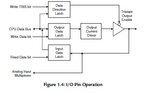electronic_satya
Member level 2
hi all,
i have this basic clarification about the input and output ports. in general a port can be configured as either input and ouptut from microcontroller can somebody explain this at the transistor level by the transistor diagram. i know that you can make the port high or low by controlling the base of the transistor how the same port can be acheived as input that is the microcontroller should read whether high or low is available at the input how does it know? and how does it remember?
thanks in advance,
regards,
Satya
i have this basic clarification about the input and output ports. in general a port can be configured as either input and ouptut from microcontroller can somebody explain this at the transistor level by the transistor diagram. i know that you can make the port high or low by controlling the base of the transistor how the same port can be acheived as input that is the microcontroller should read whether high or low is available at the input how does it know? and how does it remember?
thanks in advance,
regards,
Satya
